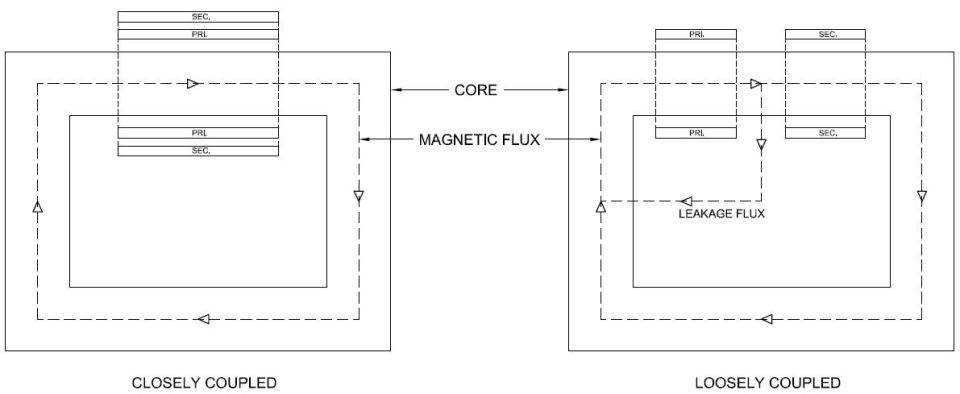Dr. Transformer: Picking up from the previous post on Step Down Auto Transformers: Eliminating Output Distortion, I promised to cover ‘closely vs loosely coupled’ windings. Magnetics designers commonly use the terms ‘closely coupled’ and ‘loosely coupled’ to describe winding configurations, and though they may know what the terms mean, they may not be understood by other engineers, including those who are responsible for applications using step down auto transformers.
In the ‘closely coupled’ configuration we say that all the flux that links the primary winding also links the secondary. In ‘loosely coupled’, a portion of the primary flux becomes ‘leakage flux’, does not link the secondary, which can cause loss of secondary voltage and also acts electrically as a high reactance in series with the primary.
In the ‘closely coupled’ configuration we say that all the flux that links the primary winding also links the secondary. In ‘loosely coupled’, a portion of the primary flux becomes ‘leakage flux’, does not link the secondary, which can cause loss of secondary voltage and also acts electrically as a high reactance in series with the primary.
‘Closely Coupled’ versus ‘Loosely Coupled’ Winding Configurations
This leakage flux can have other undesirable effects such as causing stray winding heating as well as stray heating to clamps or other close magnetics objects. That having been said, designers occasionally choose the configuration where it is desirable to limit short circuit current, as for some tube filaments.
Most typically in power applications, ‘closely coupled’ are used. It is also worth noting that to be considered ‘closely coupled’ both the primary and secondary windings must occupy the entire traverse. Sometimes designers unintentionally create a loosely coupled configuration by not fully occupying the traverse. When that happens, performance suffers, and excess heating results, which eventually leads to shorter life of the unit (remembering the rule of thumb: every decrease of 10C doubles the life of the transformer).
Application and systems design engineers need to have an awareness of this issue as they discuss the specifications and application with the transformer designer. As always, performance comes at a price, and highly experienced transformer designers use these sound design practices and conservative approach to ensure the ‘closely coupled’ design is optimal for the application. If the transformer designer is inexperienced and not well versed in this principle, perhaps looking for another vendor is warranted.
It is up to the applications engineer or systems design engineer to ensure they are sufficiently knowledgeable to select the step down auto transformer that will deliver the optimum performance for their system, and not fall into the trap of specifying a step down auto transformer based on price.
Hmmm…. Speaking of coupled, where is Docta Reacta? I seem to remember he is due to make an appearance for another lecture here at the PMI Institute…….
Most typically in power applications, ‘closely coupled’ are used. It is also worth noting that to be considered ‘closely coupled’ both the primary and secondary windings must occupy the entire traverse. Sometimes designers unintentionally create a loosely coupled configuration by not fully occupying the traverse. When that happens, performance suffers, and excess heating results, which eventually leads to shorter life of the unit (remembering the rule of thumb: every decrease of 10C doubles the life of the transformer).
Application and systems design engineers need to have an awareness of this issue as they discuss the specifications and application with the transformer designer. As always, performance comes at a price, and highly experienced transformer designers use these sound design practices and conservative approach to ensure the ‘closely coupled’ design is optimal for the application. If the transformer designer is inexperienced and not well versed in this principle, perhaps looking for another vendor is warranted.
It is up to the applications engineer or systems design engineer to ensure they are sufficiently knowledgeable to select the step down auto transformer that will deliver the optimum performance for their system, and not fall into the trap of specifying a step down auto transformer based on price.
Hmmm…. Speaking of coupled, where is Docta Reacta? I seem to remember he is due to make an appearance for another lecture here at the PMI Institute…….



